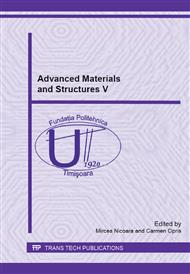p.128
p.134
p.140
p.146
p.151
p.157
p.163
p.169
p.175
Measurement of Young’s Modulus and Shear Modulus of Some Structures Welded Using Flux Cored Wire by Vibration Tests
Abstract:
The aim of this work was to determine by vibration tests the longitudinal elastic modulus and shear modulus of welded joints by flux cored arc welding. These two material properties are characteristic elastic constants of tensile stress respectively torsion stress and can be determined by several non-destructive methods. One of the latest non-destructive experimental techniques in this field is based on the analysis of the vibratory signal response from the welded sample. An algorithm based on Pronys series method is used for processing the acquired signal due to sample response of free vibrations. By the means of Finite Element Method (FEM), the natural frequencies and modes shapes of the same specimen of carbon steel were determined. These results help to interpret experimental measurements and the vibration modes identification, and Youngs modulus and shear modulus determination.
Info:
Periodical:
Pages:
151-156
Citation:
Online since:
August 2014
Authors:
Price:
Сopyright:
© 2014 Trans Tech Publications Ltd. All Rights Reserved
Share:
Citation:


